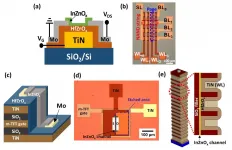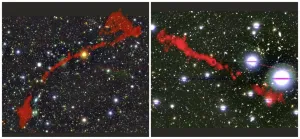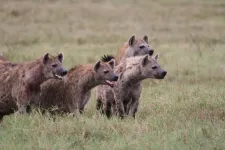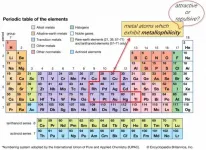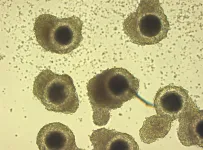Zebra stripes, leopard spots: frozen metal patterns defy conventional metallurgy
Pattern formation in liquid metal a key to future electronics
2021-01-19
(Press-News.org) "Stripy zebra, spotty leopard, ...". Kids never become bored pinpointing animals based on their unique body patterns. While it is fascinating that living creatures develop distinct patterns on their skin, what may be even more mysterious is their striking similarity to the skin of frozen liquid metals.
Pattern formation is a classic example of one of nature's wonders that scientists have pondered for centuries. Around 1952, the famous mathematician Alan Turing (father of modern computers) came up with a conceptual model to explain the pattern formation process of a two-substance system. Such patterns are also called Turing patterns thereafter.
Pattern formation is also commonly adopted by manmade systems and this is especially true in the field of metallurgy. It even has a sub-field called 'metallography', which specialises in the study of microscale patterns and compositions of metals and alloys. If you snap a multi-component alloy apart and take a look at its cross sections, there is a good chance that you will see alternating stripes or aligned spots of different metal components, just like a microscopic version of the patterns on the skin of a zebra or leopard. However, despite the ancient knowledge about the core of liquid metal alloys and their bulk solidification patterns, their surface pattern formation phenomenon has long been overlooked until now.
In a work published in the journal Nature Nanotechnology, researchers from the University of New South Wales (UNSW) Sydney and their collaborators from the University of Auckland (the MacDiarmid Institute), RMIT, and UCLA discovered that diverse types of patterns occur at the surface of solidified metal alloys. The team used two-component metallic mixes, such as gallium-based alloys containing small amounts of bismuth. These alloys easily melt in one's hand and thus make experimental observation and control convenient.
"We could observe the surface solidification process under an ordinary optical microscope and I was astonished when I first saw a solidification front on the liquid metal surface creating solid patterns behind it," said Dr. Jianbo Tang, the leading author of the work. "You can imagine the scene of a glacier moving across the ocean surface, but everything seen under our microscope is metallic and microscopic." Dr. Tang added.
To see the finer details of the metallic glacier, electron microscopy was used, and the researchers observed a kaleidoscope of highly ordered patterns including alternating stripes, curved fibres, dot arrays, and some exotic stripe-dot hybrids. Surprisingly, the team found that, when these patterns are formed, the abundance of the low-concentration element bismuth at the surface region was much increased. Such surface enrichment found in this study defies conventional metallurgical understandings.
The researchers related the magic behind this newly observed solidification phenomenon to the unique surface structures of liquid metals and they also used super computers to simulate the process. In their computer simulations, the small-in-number bismuth atoms, seemingly moving around randomly in a sea of gallium atoms, were observed to accumulate at the alloy surface.
"This previously ignored surface solidification phenomenon improves our fundamental understanding of liquid metal alloys and their phase transition processes. In addition, this autonomous surface process can be used as a patterning tool for designing metallic structures and creating devices for advanced applications in future electronics and optics." said Prof. Kourosh Kalantar-Zadeh, a corresponding author of the study.
INFORMATION:
The collaboration between UNSW and the MacDiarmid Institute for Advanced Materials and Nanotechnology was established by Australian Research Council (ARC) Centre of Excellence Future Low-Energy Electronics Technologies (FLEET).
THE STUDY
Unique surface patterns emerging during solidification of liquid metal alloys was published in Nature Nanotechnology January 2021
(DOI 10.1038/s41565-020-00835-7)
ELSE PRESS RELEASES FROM THIS DATE:
2021-01-19
Fungi are among the world's oldest and most tenacious organisms. They are now showing great promise to become one of the most useful materials for producing textiles, gadgets and other construction materials. The joint research venture undertaken by the University of the West of England, Bristol, the U.K. (UWE Bristol) and collaborators from Mogu S.r.l., Italy, Istituto Italiano di Tecnologia, Torino, Italy and the Faculty of Computer Science, Multimedia and Telecommunications of the Universitat Oberta de Catalunya (UOC) has demonstrated that fungi possess ...
2021-01-19
The compulsory collection of DNA being undertaken in some parts of the world is not just unethical, but risks affecting people's willingness to donate biological samples and thus contribute to the advancement of medical knowledge and the development of new treatments, says a paper in the European Journal of Human Genetics, published online* today [18 January 2021].
Citing abuses being carried out in China, Thailand, and on the US/Mexico border, the authors1 call on scientific journals to reexamine all published papers based on databases that do not meet accepted standards of ethical approval, and demand an end to collaborations between academic institutions worldwide and those in countries carrying out unethical DNA collections. ...
2021-01-19
As we enter the era of superintelligence and hyper-connected Fourth Industrial Revolution, the importance of high-density and high-performance memory is greater than ever. Currently, the most widely used NAND flash memory has issues of high power consumption, slow operation speed, and vulnerability to repetitive use since it relies on the charge trap effect to store information. To this, a POSTECH research team has recently demonstrated a ferroelectric memory that exceedingly surpasses the performance of the conventional flash memory in terms of operation speed, power consumption, and device reliability.
A POSTECH research team - led by Professor Jang-Sik Lee, and Ph.D. candidates Min-Kyu Kim and Ik-Jyae Kim of the Department ...
2021-01-19
Maxwell equations govern the evolution of electromagnetic fields with light being a particular solution of these equations in spaces devoid of electric charge. A new study published in EPJ C by Alexei Morozov and Nikita Tselousov, from the Moscow Institute of Physics and Technology and the Institute of Transmission Problems, Russia, respectively, details peculiar solutions to the Maxwell equations--so-called Maxwell knots. The research could have applications in the fields of mathematical physics and string theory.
"We usually think of light as the plane waves. It was a breakthrough when ...
2021-01-19
Two giant radio galaxies have been discovered with South Africa's powerful MeerKAT telescope. These galaxies are thought to be amongst the largest single objects in the Universe. The discovery has been published today in Monthly Notices of the Royal Astronomical Society.
Whereas normal radio galaxies are fairly common, only a few hundred of these have radio jets exceeding 700 kilo-parsecs in size, or around 22 times the size of the Milky Way. These truly enormous systems are dubbed 'giant radio galaxies'.
Despite the scarcity of giant radio galaxies, the authors found two of these cosmic beasts in a remarkably small patch of sky.
Dr Jacinta Delhaize, a Research Fellow at the ...
2021-01-19
Scientists from the Leibniz Institute for Zoo and Wildlife Research (Leibniz-IZW) have found that interacting with other males is more "stressful" for low-ranking than for high-ranking male spotted hyenas. This restricts the time and energy low-ranking males can invest in courting the most desirable females and is therefore a key factor for their lower reproductive success than their high-ranking rivals. This mechanism seems to be more important in determining the number and quality of offspring than physical traits such as attractiveness and fighting ability. These insights were possible owing to a combination of extensive field and lab work - over 20 years of searching and identifying thousands ...
2021-01-19
A research team led by Professor Chi-Ming CHE and Dr Jun YANG, from the Research Division for Chemistry and Department of Chemistry at the Faculty of Science of the University of Hong Kong, has resolved a long-standing fundamental problem in the field of metal-metal closed-shell interaction. This work has been published in the journal Proceedings of the National Academy of Sciences (PNAS).
Metal-Metal closed-shell interaction, also known as metallophilicity, has a huge impact in diverse fields of chemistry, such as supramolecular chemistry and organometallic chemistry. Early reports on metallophilicity could be traced back to the 1970s. Many leading theoretical chemists ...
2021-01-19
According to current studies, the COVID-19 disease which is caused by the SARS-CoV-2 coronavirus comprises at least five different variants. These differ in how the immune system responds to the infection. Researchers from the German Center for Neurodegenerative Diseases (DZNE) and the University of Bonn, together with other experts from Germany, Greece and the Netherlands, present these findings in the scientific journal "Genome Medicine". Their results may help to improve the treatment of the disease.
Infection with SARS-CoV-2 can manifest in different ways: Many of those affected do not even seem to notice the presence of the virus in their bodies. In other ...
2021-01-19
In order to achieve the goals of the Paris Agreement, the world must reach net-zero carbon emissions by 2050. Carbon pricing is viewed by many governments and experts as the most important climate policy instrument. However, a new study shows that carbon pricing has been less effective as a driver of technological change than was previously anticipated.
While the introduction of carbon pricing systems has led to emissions reductions in some countries, they have not significantly stimulated technological change. Bringing about the necessary transformation will require sector-specific promotion of climate-friendly technologies, for example ...
2021-01-19
For this specific method of cryopreservation, oocytes are collected directly after an animal is castrated or deceased and immediately frozen at -196°C in liquid nitrogen. This technique allows the storage of oocytes of valuable animals for an unlimited time, so that they can be used to produce offspring with the help of assisted reproduction techniques. The aim is to further improve and apply these methods to save highly endangered species such as the Asiatic lion from extinction. The current research on African lions as a model species is an important step in this direction. The results are reported in the scientific journal Cryobiology.
Lion oocytes are presumed to be very sensitive to chilling due to their high lipid content, resulting ...
LAST 30 PRESS RELEASES:
[Press-News.org] Zebra stripes, leopard spots: frozen metal patterns defy conventional metallurgy
Pattern formation in liquid metal a key to future electronics
